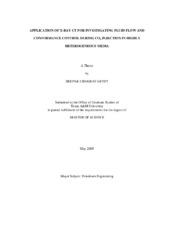| dc.description.abstract | Fractured reservoirs have always been considered poor candidates for enhanced
oil recovery. This can be attributed to the complexities involved in understanding and
predicting performance in these reservoirs. In a fractured system, the high permeability
fracture forms the preferred pathway for the injected fluids, and a large amount of oil that
is stored in the matrix is bypassed. Hence, a good understanding of multiphase fluid flow
in fractures is required to reduce oil bypass and increase recovery from these reservoirs.
This research investigates the effect of heterogeneity and injection rates on oil bypass and
also the various techniques used for the improvement of sweep efficiency in
heterogeneous systems. Several coreflood experiments were performed using
homogeneous and heterogeneous cores and a 4th generation X-Ray CT scanner was used
to visualize heterogeneity and fluid flow in the core. Porosity and saturation
measurements were made during the course of the experiment.
The experimental results indicate that injection rates play a very important role in
affecting the recovery process, more so in the presence of fractures. At high injection
rates, faster breakthrough of CO2 and higher oil bypass were observed than at low
injection rates. But very low injection rates are not attractive from an economic point of
view. Hence water viscosified with a polymer was injected directly into the fracture to
divert CO2 flow into the matrix and delay breakthrough, similar to the WAG process.
Although the breakthrough time reduced considerably, water ??leak off?? into the matrix
was very high. To counter this problem, a cross-linked gel was used in the fracture for
conformance control. The gel was found to overcome ??leak off?? problems and effectively
divert CO2 flow into the matrix. This experimental research will serve to increase the
understanding of fluid flow and conformance control methods in fractured reservoirs. | en |


